Major League Baseball (MLB) is a complex yet fascinating world where teams compete for glory in a challenging environment. Understanding MLB teams and their divisions is crucial for any baseball fan or sports enthusiast. This article aims to provide insights into the teams, divisions, and the rich history that surrounds them.
The Structure of Major League Baseball
MLB comprises two major leagues: the American League (AL) and the National League (NL), each further divided into three divisions. These divisions play a significant role in determining playoff matchups and regularseason competitions. Here’s a breakdown of the teams and their respective divisions:
East Division
New York Yankees
Boston Red Sox
Toronto Blue Jays
Tampa Bay Rays

Baltimore Orioles
Central Division
Chicago White Sox
Cleveland Guardians
Detroit Tigers
Kansas City Royals
Minnesota Twins
West Division
Houston Astros
Seattle Mariners
Texas Rangers
Los Angeles Angels
Oakland Athletics
East Division
Atlanta Braves
Philadelphia Phillies
New York Mets
Miami Marlins
Washington Nationals
Central Division
St. Louis Cardinals
Milwaukee Brewers
Cincinnati Reds
Chicago Cubs
Pittsburgh Pirates
West Division
Los Angeles Dodgers
San Francisco Giants
San Diego Padres
Arizona Diamondbacks
Colorado Rockies
The Role of Divisions in Competitive Play
The divisions in MLB are not just organizational; they significantly influence the dynamics of the competition. Each team faces its divisional rivals multiple times during the season, which heightens the stakes for every game. This setting fosters rivalries and creates intense competition, making divisional games critical for playoff berths.
Tips for Engaging with MLB Teams and Divisions
To enhance your understanding and appreciation of MLB teams and their divisions, consider the following productivityenhancing techniques:
Explanation: Staying updated on team rosters, injuries, and trades helps deepen your knowledge of how teams prepare and compete.
Application
Explanation: There’s no substitute for the atmosphere of live baseball. Attending games or watching them on TV can elevate your experience.
Application: Plan trips to stadiums or gather with friends for watch parties, immersing yourself in the excitement of the game.
Explanation
Application : Join online forums, social media groups, or local clubs to share insights and discuss teams and players.
Explanation : MLB is rich with statistics that can provide deeper insights into team performance and player metrics.
Application : Familiarize yourself with advanced statistics like WAR (Wins Above Replacement) or OPS (Onbase Plus Slugging) that offer a more nuanced view of player contributions.
Explanation : Understanding a team’s history offers context to their current status and rivalries.
Application
FAQs about MLB Teams and Divisions
Answer: MLB consists of two leagues, the American League (AL) and National League (NL), each holding three divisions: East, Central, and West. Teams are grouped based on geographic location and historical rivalries to enhance competition and fan interest.
Answer : Divisional rivalries play a crucial role in the competitive landscape of MLB. Teams face each other multiple times during the season, making these matchups important for playoff eligibility and increasing fan engagement.
Answer
Answer: Teams evaluate trade opportunities based on player performance, team needs, and financial considerations. Trades can happen within or between divisions, and teams often aim to strengthen their lineup or rebuild through trades.
Answer : The MLB draft allows teams to select eligible players, impacting their roster and performance in future seasons. Teams with lower performance records often have earlier picks, providing them with opportunities to improve their talent base.
Answer: Teams can switch divisions, though it's a rare occurrence driven by factors like expansion or franchise relocation. Such decisions are typically made by MLB leadership and involve substantial logistical considerations.
Understanding MLB teams and their divisions is central to fully appreciating the sport's culture and competitive nature. Whether through statistics, fan engagement, or history, deepening your knowledge will undoubtedly enhance your experience as a fan. As you explore the rich tapestry of Major League Baseball, remember that each season brings new narratives and excitement, making it an everevolving sport to follow.